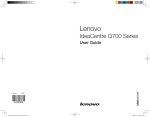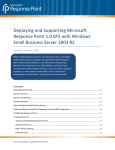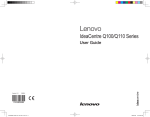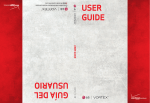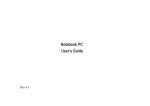Download Alldaymall Tablet PC User Manual-English
Transcript
Table of contents 1. Get started1 Turn on & sign in 1 Charge the battery 2 2. Make yourself at home 3 Relax with Google Play 3 Manage downloads 5 Use apps 6 Organize your Home screens 7 Change sound settings 8 Change the wallpaper 8 3. Tune performance 10 Optimize battery life 10 optimize data usage 11 optimize memory usage 13 4. Enter & edit text 16 use the keyboard 16 Type text by speaking 18 i 5. Connect to networks 20 Connect to Wi-Fi networks 20 Connect to virtual private networks 24 6. Connect to devices 26 Connect to keyboards, mice, & other devices Connect to a Windows computer via USB Connect to a Macintosh computer via USB 26 28 28 7. Manage accounts 30 Add or remove accounts 30 Configure sync options 31 Change backup & reset options 33 8. Secure your tablet 35 Set screen lock 35 37 Encrypt your tablet ii 1 Get started Turn on & sign in To turn on your tablet, press the Power button for a few seconds, then release it. The first time you turn on the tablet, you’ll see a Welcome screen. • To choose a different language, touch the menu. • To continue, touch Start and follow the instructions. When prompted, sign in using the email address and password for your Google Account. If you don’t have one yet, create one. An email address that you use for any of the following counts as a Google Account: • • • • • Gmail YouTube Google Apps AdWords Any other Google product get started 1 When you sign in with a Google Account, all the email, contacts, Calendar events, and other data associated with that account are automatically synced with your tablet. If you have multiple Google Accounts, you can add the others later. Charge the battery The printed Quick Start Guide that comes with tablet contains basic operating instructions for your new tablet. The battery may not be fully charged at first. It’s a good idea to fully charge it as soon as you can. Connect the micro USB cable to tablet and to the charging unit, and the charging unit to a power outlet: a Important: Use the charging unit and micro USB cable that come with your tablet. Other charging units and USB cables may charge more slowly or not at all. get started 2 2 Make yourself at home Relax with Google Play Google Play brings together all your favorite content in one place – movies, TV shows, books, music, magazines, apps, and more – so you can reach it from any of your devices. Shop on Google Play To open the Google Play store app, touch the Play store icon in your Favorites tray at the bottom of every Home screen. Play Store Most things you purchase on Google Play are available from your computer as well as from any of your Android mobile devices. (Android apps are one exception – they run only on Android devices.) sign in to play.google.com to get your entertainment from anywhere. Make yourself at home 3 Find your content If you purchased on Google Play in the past, you’ll automatically have access to this content on your tablet — just make sure you’re signed in using the same account that you used to purchase it. You can get to your content using any of the Google Play icons in your Favorites tray, including Books, Magazines, Movies, and Music. Play Store icon to open Google Play. In the top Or, touch the right corner, to the left of the Menu and Search icons, you’ll find a My Library icon corresponding to the section of Google Play you’re currently viewing. For example, while browsing the Movies & TV section, you’ll see the Google Play Movies app icon, which will take you to My Movies & TV: Touch icon in this location to see your content of that type You can quickly access your content this way, from the Google Play Store app, even if you originally purchased it on Google Play using a different phone or tablet. If you get a new device, all your media will automatically be waiting for you here when you turn on and sign in. Google Play settings To adjust your Google Play settings, switch accounts, or get help, Menu in the top right choose the option you want from the corner. Make yourself at home 4 The Google Play Settings screen lets you control when you’re notified about updates to apps and games, clear your search history, and enable user controls. To filter Android apps based on maturity level or require a PIN before completing any purchase, touch Content filtering or Set or change PIN. Google Play support For more detailed information about Google Play, including phone and email support options, visit support.google.com/googleplay. Manage downloads Downloads To manage most downloads, touch the Downloads icon on the All Apps screen. Note that movies and some other content can be downloaded to your tablet but won’t show up in the Downloads app. Unless you pin (download) content such as books or movies to your tablet so you can access it offline, Google Play streams your purchases and rentals from Google servers while you’re playing them – so they don’t occupy any permanent storage space. In addition to downloading content from Google Play, you can download files from Gmail messages or a variety of other sources. Use the Downloads app to view, reopen, or delete what you’ve downloaded in this way. From the Downloads app: • Touch an item to open it. • Touch headings for earlier downloads to view them. Share • Check items you want to share. Then touch the icon and choose a sharing method from the list. Trash icon. • Check items you want to delete. Then touch the Make yourself at home 5 • At the bottom of the screen, touch Sort by size or Sort by date to switch back and forth. Files available in the Download app can also be viewed in the Download directory that’s visible when your tablet is connected to a computer. You can view and copy files from this directory. Use apps To see all your apps, touch any Home screen. All Apps in the Favorites tray on The main All Apps screen opens. This is where you can see all your apps, including those downloaded on Google Play. You can move app icons to any of your Home screens. From All Apps, you can: • Move between screens. Swipe left or right. • Open an app. Touch its icon. • Place an app icon on a Home screen. Touch & hold the app icon, slide your finger, and lift your finger to drop the icon in place. • Browse widgets. Touch the Widgets tab at the top of any All Apps screen. • Get more apps. Touch the Play Store icon in the list of app icons, or the Shop icon at the upper right. To remove an app icon from the Home screen, touch & hold it, slide your finger toward the top of the screen, and drop the app Remove icon . over the To view info about an app from an All App screen, touch & hold it, slide your finger toward the top of the screen, and drop the app App Info icon . over the Make yourself at home 6 Most apps include a Menu icon near the top or bottom of the screen that lets you control the app’s settings. Organize your Home screens To add a widget to a Home screen: 1. Go to the Home screen where you want to place the widget. All Apps icon. 2. Touch the 3. Swipe right to the Widgets tab and keep swiping, if necessary, to find the widget. 4. Touch & hold the widget until the Home screen appears, slide it into place, and lift your finger. To move an app or widget icon to a different location on a Home screen: 1. Touch & hold the icon. 2. Slide your finger to the new position. To move between Home screens, slide toward the edge of the screen. To bump another icon out of the way, slide slowly into it. 3. Lift your finger. The icon drops into its new position. To combine two icons in a folder, slide one quickly over the other. To open a folder, touch it. To rename a folder, touch its name. Make yourself at home 7 Change sound settings Your tablet uses sounds to communicate, including notifications, alarms, and navigation feedback. To customize the sounds your tablet makes, go to Device > Sound: Settings > • Volumes sets the master volume separately for music, notifications, and alarms. You can still use the physical volume control on the tablet to raise or lower volume of whatever sound is currently playing. • Default notification announces the arrival of notifications unless you specify a different sound in an individual app. • Touch sounds give audible feedback when you touch active icons or buttons on the screen. • Screen lock sound is triggered when you unlock the screen. Change the wallpaper Wallpapers can include images from Gallery, still images included with the system, and live images, such as an animation or a map that centers on your location. They take the place of the default background for your Home screens. 1. Touch & hold anywhere on a Home screen that’s not occupied. A list of options appears. Make yourself at home 8 2. Touch a wallpaper source: Gallery. Choose from pictures that you’ve synced with your tablet. Live Wallpapers. Choose from a scrolling list of animated wallpapers. Wallpapers. Choose from thumbnails of default images, or touch a thumbnail for a larger version. You can download additional wallpapers on Google Play. 3. To set a wallpaper, touch Set wallpaper or, for Gallery images, determine the cropping and touch Crop. To change your tablet’s wallpaper, go to Settings > Device > Display > Wallpaper. Settings Make yourself at home 9 3 Tune performance Optimize battery life To control Battery settings, go to Settings > Device > Battery. You can extend your battery’s life between charges by turning off features that you don’t need. You can also monitor how apps and system resources consume battery power. Extend the life of your battery • If you aren’t using Wi-Fi, Bluetooth, or GPS, use the Settings app to turn them off. The GPS setting is located in Settings > Personal > Location services. • Don’t leave the Maps or Navigation apps open on the screen when you’re not using them. They use GPS (and thus more power) only when they’re running. • Turn down screen brightness and set a shorter Sleep timeout: Settings > Device > Display. • If you don’t need it, turn off automatic syncing for all apps: Settings > Accounts > Google account-name. This means you Tune performance 10 need to sync manually to collect messages, email, and other recent information, and won’t receive notifications when updates occur. • If you know you won’t be near a Wi-Fi network for a while, switch to Airplane mode: press and hold the Power button, or go to Settings > Wireless & Networks > More > Airplane mode. Check battery level and usage details Open Settings > Device > Battery. The list at the bottom of the screen shows the breakdown of battery usage for individual apps and services. Touch a graph for more details. The details screen for some apps includes buttons that allow you to adjust settings affecting power usage, or stop the app completely. Warning: If you stop some apps or services, your device may not work correctly. Battery status (charging, discharging) and level (as a percentage of fully charged) are displayed at the top of the screen. The discharge graph shows battery level over time since you last charged the device, and how long you’ve been running on battery power. Optimize data usage Data usage refers to the amount of data uploaded or downloaded by your device during a given period. To monitor your data usage, Settings > Wireless & networks > Data usage. go to Tune performance 11 Data usage settings allow you to: • View data usage by app and access app settings. • Identify mobile hotspots and restrict background downloads that may result in extra charges. To view mobile hotspot settings, touch hotspots. Menu > Mobile Near the top of the screen, note the data usage cycle. Touch it to choose a different cycle. This date range is the period of time for which the graph displays data usage. The vertical white lines on the graph show a period of time within the data usage cycle. This range determines the usage amount displayed just below the graph. Drag lines to change the period. View data usage by app Some apps transfer data in the background — that is, when you’re not actually using the app, it may download data for future reference. Some apps allow you to restrict background data usage from the app’s own settings. Touch the graph for any app in the bottom part of the screen for more usage details and access to its settings. Set auto-sync You can also conserve data usage by syncing your apps manually, only when you need the data, rather than relying on auto-sync. Menu > Auto-sync data. To turn auto-sync off or on, touch Tune performance 12 Optimize memory usage You typically don’t need to worry about managing apps beyond installing, opening, and using them. But there may be times when you want to know more about what’s happening behind the scenes. Apps use two kinds of memory: internal storage and RAM. They use internal storage for themselves and any files, settings, and other data they use. They also use RAM (memory designed for temporary storage and fast access) when they’re running. Android manages and carefully guards the portion of internal storage where the system, apps, and most data for those apps are stored, because this area may contain your private information. It’s not possible to view this portion of internal storage when you connect your device to a computer with a USB cable. The other portion of internal storage, where music, downloaded files, and so on are stored, remains visible for your convenience. Android also manages how apps use RAM. It may cache some things you’ve been using recently, for quicker access if you need them again, but it will erase the cache if it needs the RAM for new activities. You affect the way apps use internal storage directly and indirectly in many ways — for example, by: • • • • • Installing or uninstalling apps. Downloading files in Chrome, Gmail, and other apps. Creating files (for example, by taking pictures). Deleting downloaded files or files you created. Copying files between your device and a computer via USB or Bluetooth. Tune performance 13 You rarely need to manage the way apps use RAM. But you can monitor apps’ RAM usage and stop them if they misbehave. Use the Apps screen The Apps screen allows you to adjust several aspects of the way your device uses memory. To view these settings, go to Settings > Device > Apps. Settings You’ll see three tabs at the top of the screen, each displaying a list of apps or their components: • Downloaded. Displays apps you’ve downloaded on Google Play or other sources. • Running. Displays all apps, processes, and services that are currently running or that have cached processes, and how much RAM they are using. The graph at the bottom of the Running tab shows the total RAM in use and the amount free. At the top right of the screen, touch Show cached processes or Show running services to switch back and forth. • All. Displays all apps that came with Android and all apps you downloaded on Google Play or other sources. To switch the order of the lists displayed in the Downloaded or All Menu > Sort by name or Sort by size. tabs, touch To view details about an app or other item listed under any tab, touch its name. The information and controls available vary among different types of apps, but commonly include: • Force stop button. Stops an app that is misbehaving. Stopping an app, process, or service may cause your device to stop working correctly. You may need to restart your device after doing this. Tune performance 14 • Uninstall button. Deletes the app and all of its data and settings. • Disable button. Prevents the app from running, but does not uninstall it. This option is available for some apps and services that can’t be uninstalled. • Clear data button. Delete an app’s settings and other data without removing the app itself. • Clear cache button. If the app stores data in a temporary area of the tablet’s memory, lists how much information is stored, and includes a button for clearing it. • Launch by default. If you have configured an app to launch certain file types by default, you can clear that setting here. • Permissions. Lists the kinds of information about your tablet and data the app has access to. Tune performance 15 4 Enter & edit text Use the keyboard You can enter text using the onscreen keyboard. Some apps open it automatically. In others, you open it by touching where you want to type. Touch a suggestion to type it Touch & hold to type this character Touch & hold to see input and keyboard settings Touch & hold to choose a smiley face enter & edit text 16 To make the keyboard go away, touch the modified ton below it. Back but- Basic editing • Move the insertion point. Touch where you want to type. The cursor blinks in the new position, and a blue tab appears below it. Drag the tab to move the cursor. • Select text. Touch & hold or double-tap within the text. The nearest word highlights, with a tab at each end of the selection. Drag the tabs to change the selection. The tab disappears after a few moments. To make it reappear, touch the text again. to delete selected text or the charac• Delete text. Touch ters before the cursor. • Type capital letters. Touch the Shift key once to switch to capital letters for one letter. Shift key while you type. When you release Or touch & hold the key, the lowercase letters reappear. Shift key, so it • Turn caps lock on. Double-tap or touch & hold Shift key again to return to lowercase. changes to . Touch • Cut, copy, paste. Select the text you want to manipulate. Then Cut, Copy or Paste button: touch enter & edit text 17 To change your tablet’s keyboard and input methods, go to Settings > Personal > Language & input. Settings Type text by speaking You can use voice input to type text by speaking. This feature uses Google’s speech-recognition service, so your tablet must be connected to a Wi-Fi network to use it. Text that you enter by speaking is underlined. You can continue entering text to keep it, or delete it. You can speak to enter text in most places that you can enter text with the onscreen keyboard. • Touch a text field, or a location in text you’ve already entered in a text field. Microphone key on the onscreen keyboard. • Touch the • When you see the microphone image, speak what you want to type. Say “comma,” “period,” “question mark,” “exclamation mark,” or “exclamation point” to enter punctuation. When you pause, what you spoke is transcribed by the speechrecognition service and entered in the text field, underlined. You can touch the Delete key to erase the underlined text. If you start typing or entering more text by speaking, the underline disappears. To improve processing of your voice input, Google may record a few seconds of ambient background noise in temporary memory enter & edit text 18 at any time. This recording remains on the device only fleetingly and is not sent to Google. To change your tablet’s speech settings, go to Settings > Personal > Language & input. Settings enter & edit text 19 5 Connect to networks Connect to Wi-Fi networks To work with Wi-Fi settings, go to works > Wi-Fi. Settings > Wireless & net- Wi-Fi is a wireless networking technology that can provide Internet access at distances of up to 100 meters, depending on the Wi-Fi router and your surroundings. To use Wi-Fi, you connect to a wireless access point, or “hotspot.” Some hotspots are open and you can simply connect to them. Others implement security features that require other steps to set up, such as digital certificates or other ways to ensure that only authorized users can connect. To extend the life of your battery between charges, turn off Wi-Fi when you’re not using it. You can also set your device to disconnect automatically from Wi-Fi networks when it’s sleeping. Connect to networks 20 Turn Wi-Fi on & connect to a Wi-Fi network If you’re adding a Wi-Fi network when first setting up your device, Wi-Fi is turned on automatically. Settings > Wireless & networks > Wi-Fi. 1. Touch 2. Slide the Wi-Fi switch to the On position. The device scans for available Wi-Fi networks and displays the names of those it finds. Secured networks are indicated with a Lock icon. If the device finds a network that you connected to previously, it connects to it. 3. Touch a network name to see more details or connect to it, and type a password if necessary. Or, if your Wi-Fi router supports Wi-Fi Protected Setup, touch WPS icon on your tablet, and then touch the same butthe ton on your router. To modify a network’s settings, touch & hold the network name. Add a Wi-Fi network You can add a Wi-Fi network so your device will remember it, along with any security credentials, and connect to it automatically when it’s in range. You must also add a Wi-Fi network if the network does not broadcast its name (SSID), or to add a Wi-Fi network when you are out of range. To join a secured network, you first need to learn security details from the network’s administrator. 1. Turn on Wi-Fi, if it’s not already on. Plus icon at the top of the screen. 2. Touch the 3. Enter the SSID (name) of the network. If necessary, enter security or other network configuration details. 4. Touch Save. Connect to networks 21 The information about the network is saved. Your device will connect to this network automatically the next time you come within range. Forget a Wi-Fi network You can make the tablet forget about the details of a Wi-Fi network that you added—for example, if you don’t want the tablet to connect to it automatically or if it’s a network that you no longer use. 1. Turn on Wi-Fi, if it’s not already on. 2. In the Wi-Fi settings screen, touch the name of the network. 3. Touch Forget in the dialog that opens. Configure proxy settings for a Wi-Fi network Some network administrators require you to connect to internal or external network resources via a proxy server. By default, the Wi-Fi networks you add are not configured to connect via a proxy, but you can change that for each Wi-Fi network you’ve added. Proxy settings are used by Browser but may not be used by other apps. 1. Touch & hold a network in the list of Wi-Fi networks you’ve added. 2. Touch Modify network in the dialog that opens. 3. Select Show advanced options. 4. If the network has no proxy settings, touch None under Proxy Settings, then touch Manual in the menu that opens. 5. Enter the proxy settings supplied by your network admini strator. 6. Touch Save. Connect to networks 22 The proxy settings apply only to the Wi-Fi network you modified. To change the proxy settings for other Wi-Fi networks, modify them individually. Set Wi-Fi notifications, disconnect policy, & other advanced options To work with advanced Wi-Fi settings: 1. Turn on Wi-Fi, if it’s not already on. 2. In the Wi-Fi settings screen, touch Menu > Advanced. These are the settings you can adjust: • Network notification. By default, when Wi-Fi is on, you receive notifications in the Status bar when your device detects an open Wi-Fi network. Uncheck this option to turn off notifications. • Keep Wi-Fi during sleep. To conserve mobile data usage, your device stays connected to Wi-Fi when the screen goes to sleep. Touch this option to change this default behavior: either to stay connected to Wi-Fi only when the device is connected to a charger (when battery life isn’t a problem), or never to stay connected to Wi-Fi during sleep. This screen also displays the following information: • MAC address. The Media Access Control (MAC) address of your device when connected to a Wi-Fi network. • IP address. The Internet Protocol (IP) address assigned to the device by the Wi-Fi network you are connected to (unless you used the IP settings to assign it a static IP address). Connect to networks 23 To turn Wi-Fi on or off, go to & networks > Wi-Fi. Settings Settings > Wireless To manage data usage and mobile hotspots, go to Settings > Wireless & networks > Data usage. Connect to virtual private networks Virtual private networks (VPNs) allow you to connect to the resources inside a secured local network, from outside that network. VPNs are commonly deployed by corporations, schools, and other institutions to let people access local network resources when not on campus, or when connected to a wireless network. To configure VPN access, you must first obtain the details from your network administrator. Depending on your organization’s solution, you may need to obtain a VPN app, either from your administrator or on Google Play. Settings The VPN settings screen allows you to add VPN networks and adjust their settings. To view this screen and perform the tasks described here, go to Settings > Wireless & networks > More > VPN. Add a VPN 1. From the VPN screen, touch Add VPN profile. 2. In the form that appears, fill in the information provided by your network administrator 3. Touch Save. The VPN is added to the list on the VPN screen. Connect to networks 24 Connect to a VPN 1. From the VPN screen, touch the name of the VPN. 2. In the dialog that opens, enter any requested credentials. 3. Touch Connect. When you’re connected to a VPN, a Status icon and notification are displayed continuously. To disconnect, touch the notification for the VPN connection. Edit a VPN 1. 2. 3. 4. From the VPN screen, touch & hold the name of the VPN profile. In the dialog that opens, touch Edit profile. Edit the VPN settings you want. Touch Save. Delete a VPN 1. From the VPN screen, touch & hold the name of the VPN profile. 2. Touch & hold the VPN you want to delete. 3. In the dialog that opens, touch Delete profile. Connect to networks 25 6 Connect to devices Connect to keyboards, mice, & other devices You can connect a keyboard, mouse, or even a joystick or other input device to your tablet via usb or bluetooth and use it just as you would with a PC. You may need an adapter to connect the keyboard or other device to your tablet’s usb port. To connect more than one usb device at a time, use a powered usb hub to reduce the drain on your tablet’s battery. IMPorTAnT: using external devices such as keyboards via USB will cause a significant additional drain on your battery, as will continuous use of a mouse via bluetooth. You pair and connect bluetooth input devices to your tablet in the same way as any other bluetooth device. Connect to devices 26 Keyboards In addition to entering text, you can use your keyboard to navigate your tablet’s features: • Use the arrow keys to select items on screen. • Pressing Return when an item is selected is equivalent to touching that item. • Pressing Escape is equivalent to touching Back. • Press Tab or Shift-Tab to move from field to field in a form or other screen with multiple text fields. Mice When you connect a mouse to your tablet and move the mouse, an arrow-shaped cursor appears, just as on a computer: • • • • use the mouse to move the cursor. Clicking, pressing, and dragging with the mouse button is equivalent to touching, touching & holding, and dragging with your finger. only one mouse button is supported. if your mouse has a trackball or scroll wheel, you can use it to scroll both vertically and horizontally. other input devices You can connect joysticks, gamepads, and other input devices to your tablet. if they work without special drivers or adapters on your PC, they will likely work with your tablet. However, games and other apps must be designed to support any special features of an input device, such as dedicated buttons or other controls, to take full advantage of them. Connect to devices 27 Connect to a Windows computer via USB You can use a USB cable to connect your tablet to a Windows computer and transfer music, pictures, and other files in both directions. This connection uses the MTP protocol, which is supported by most recent versions of Windows. When you connect your tablet to the USB port on your computer, its USB storage is mounted as a drive and appears on your computer screen. You can now copy files back and forth as you would using any other external device. When you’re finished, eject the tablet from within Windows before unplugging the usb cable. To change your tablet’s usb connection options, go to Settings > Device > Storage > Menu > USB computer connection. Settings Connect to a Macintosh computer via USB You can use a usb cable to connect your tablet to a computer running Mac os x with a usb cable and transfer music, pictures, and other files in both directions. This connection uses the MTP protocol, which is not supported by Mac OS X natively. Therefore, you first need to install the free Android File Transfer application on your Macintosh. it’s available from www.android.com/filetransfer, along with instructions on how to install it. Connect to devices 28 After you install Android File Transfer, follow these steps: 1. If you are using Android File Transfer for the first time, doubleclick it to open it. After you start Android File Transfer once, it opens automatically whenever you connect your device to your computer. 2. Connect your device to your computer with a USB cable. Android File Transfer starts, if it’s not already running, and opens a window that displays the contents of your device, along with storage space details at the bottom of the window. You work with this window much as if it were a Finder window: opening and closing folders, creating new folders, and dragging files to or from it and other Finder windows. Disconnect the USB cable when you’re finished. To change your tablet’s usb connection options, go to Settings > Device > Storage > Menu > USB computer connection. Settings Connect to devices 29 7 Manage accounts Add or remove accounts To reach the settings described here, start from Accounts. Settings > You can use multiple Google Accounts and Microsoft Exchange ActiveSync accounts on your device. You may also be able to add other kinds of accounts, depending on your apps. Some you can add in the Accounts section of Settings, as described here. Others you add using an app that works with those kinds of accounts. For example, you can add IMAP and POP3 email accounts with the Email app. Add an account To add some accounts, you may need to obtain details from system administrator about the service to which the account connects. For example, you may need to know the account’s domain or server address. manage accounts 30 1. Go to Settings > Accounts > Add account. 2. Touch the kind of account to add. 3. Follow the on-screen instructions. Most accounts require a username and password, but the details depend on the kind of account and the configuration of the service you’re connecting to. Depending on the kind of account, you may be asked to configure what kinds of data you want to sync, name the account, and other details. When you’re finished, the account is added in one of two places: • Google Accounts show up under Settings > Accounts > Google. • Other accounts show up under Settings > Accounts. Remove an account You can remove any account and all information associated with it from your device, including email, contacts, settings, and so on. To remove a Google account, touch its name under Settings > AcMenu > Remove counts or Settings > Accounts >Google, then account. For any other type of account go, to Settings > Accounts > account-name and look for the Remove option. Configure sync options To reach sync settings for Google accounts, start from tings > Accounts > Google. Set- You can configure synchronization options for any of your apps. You can also decide what kinds of data to synchronize for each account. manage accounts 31 For some accounts, syncing is two-directional; changes that you make to the information on your device are made to the copy of that information on the web. Your Google Account works this way. Other accounts support only one-way sync: the information on your mobile device is read-only. Some apps, such as Gmail and Calendar, have separate synchronization settings that provide more fine-grained control. For example, to control message syncing in the Gmail app, touch Menu > Manage labels, touch a label, and then Sync messages. Configure auto-sync for all apps To control Anto-sync for all apps that use it, open Settings > Data Menu and check or uncheck Auto-sync data. usage > If you turn off Auto-sync, you need to sync manually to collect messages, email, and other recent information, and won’t receive notifications when updates occur. For example, changes that you make in your People app are automatically made to your Google contacts on the web. If this option is not checked, you may be able to use an app’s tools to sync data manually. You can also sync manually to collect messages, email, and other recent information. Leaving Autosync off can help extend your battery life, but will prevent you from receiving notifications when updates occur. Configure Google Account sync settings To adjust a single Google Account’s sync settings: 1. Go to Settings > Personal > Accounts > Google. indicates that some or all of an account’s information is configured to sync automatically. manage accounts 32 indicates that none of an account’s information is configured to sync automatically. 2. Touch the account whose sync settings you want to change. 3. The Sync Settings screen opens, displaying a list of the kinds of information the account can sync. 4. Check or uncheck items as needed. Unchecking an option does not remove the information from your device; it simply stops it from being kept in sync with the version on the web. Sync a Google account manually 1. Go to Settings > Accounts > Google. 2. Touch the account whose data you want to sync. Menu > Sync now. 3. Touch Change backup & reset options To view the settings described here, go to & reset. Settings > Backup You can back up settings and other data associated with one or more of your Google Accounts. If you need to replace or factory reset your device, you can restore your data for any accounts that were previously backed up. These options are available: • Back up my data. If you check this option, a wide variety of your personal data is backed up automatically, including your Wi-Fi passwords, Browser bookmarks, a list of the apps you’ve installed on Google Play, the words you’ve added to the dictionary used by the onscreen keyboard, and most of your customized settings. Some third-party apps may also take manage accounts 33 advantage of this feature, so you can restore your data if you reinstall an app. If you uncheck this option, your data stops getting backed up, and any existing backups are deleted from Google servers. • Backup account. Displays the Google Accounts whose information gets backed up. You must sign in with one or more of these accounts on a new or reset device to retrieve the associated information. To add a new account, touch Backup account > Add account. • Automatic restore. Check this option to restore settings and other data when you reinstall an app. This feature requires that you are backing up your data with your Google Account and that the app is using the backup service. • Factory data reset. Touch this option, then Reset tablet to erase all your personal data from internal storage, including information about your Google Account, any other accounts, your system and app settings, any downloaded applications, and your music, photos, videos, and other files. After resetting your tablet, you’ll need to re-enter the same information requested when you first set up your tablet. If you’ve been backing up your data to a Google account, an option during the setup process allows you to restore it. Some third-party apps also make use of the backup service, so if you reinstall one, its settings and data are restored. manage accounts 34 8 Secure your tablet Set screen lock Depending how you use your tablet, you may want to set some form of automatic screen lock to prevent unauthorized access. If a lock has been set, the screen locks when your tabelt’s display goes to sleep. If your tablet’s playing music when the screen locks, you can continue listening or pause the selection without unlocking. To adjust your lock settings: Settings > Personal > Security > Screen lock. 1. Go to 2. Touch the type of lock you want and follow the onscreen instructions. If you have previously set a lock, you must enter the pattern, PIN, or password to unlock the lock settings. You can choose among these lock options, listed in approximate order of strength: secure your tablet 35 • Slide provides no protection, but lets you get to the Home screen quickly, or open Camera and start taking pictures immediately. • Face Unlock lets you unlock your tablet by looking at it. This is the least secure lock option. Tip: Face Unlock lets you unlock your tablet by looking at the screen. After you set it up, look under Settings > Personal > Security for two additional settings: Improve face matching and Liveness check. Use these to make Face Unlock more reliable and secure. • Pattern lets you draw a simple pattern with your finger to unlock the tablet. This is slightly more secure than Face Unlock. • PIN requires four or more numbers. Longer PINs tend to be more secure. • Password requires four or more letters or numbers. This is the most secure option, as long as you create a strong password. Password tips: For best security, specify a password that is • A least 8 characters long. • Contains a mixture of numbers, letters, and special symbols. • Doesn’t contain any recognizable words or phrases. To change when your tablet goes to sleep, go to Settings > Device > Display > Sleep. Settings To see your passwords when you input them, go to Settings > Personal > Security > Make passwords visible. secure your tablet 36 Encrypt your tablet You can encrypt all the data on your tablet: Google Accounts, app data, music and other media, downloaded information, and so on. If you do, you must enter a numeric PIN or password each time you turn on your tablet. Note that this is the same PIN or password that you use to unlock your tablet without encryption, and cannot be set independently. Warning: Encryption is irreversible. The only way to revert to an unencrypted tablet is to perform a factory data reset, which erases all your data. Encryption provides additional protection in case your tablet is stolen, and may be required or recommended in some organizations. Consult your system administrator before turning it on. In many cases the PIN or password you set for encryption is controlled by the system administrator. Before turning on encryption, prepare as follows: 1. 2. 3. 4. Set a lock screen PIN or password. Charge the battery. Plug in your tablet. Schedule an hour or more for the encryption process: you must not interrupt it or you will lose some or all of your data. When you’re ready to turn on encryption: 1. Touch Settings > Personal > Security > Encryption > Encrypt tablet. 2. Read the information about encryption carefully. The Encrypt tablet button is dimmed if your battery’s not secure your tablet 37 charged or your tablet’s not plugged in. If you change your mind about encrypting your tablet, touch the Back button. Warning: If you interrupt the encryption process, you will lose data. 3. Touch Encrypt tablet. 4. Enter your lock screen PIN or password and touch Continue. 5. Touch Encrypt tablet again. The encryption process starts and displays its progress. Encryption can take an hour or more, during which time your tablet may restart several times. When encryption is complete, you’re prompted to enter your PIN or password. Subsequently, you must enter your PIN or password each time you power on your tablet, to decrypt it. secure your tablet 38












































